Search Results
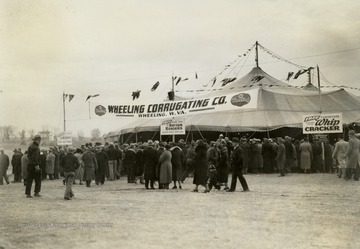
- IDNO:
- 048494
- Title:
- Crowd Outside of Wheeling Corrugating Co. Tent Listening to Rhythm Rangers Performance at National Cornhusking Championship, Marshall, MO
- Date:
- 1937
- Description:
- The Rhythm Rangers were radio stars on the "It's Wheeling Steel" radio broadcast, which was created in 1936 by Wheeling Steel Corporation advertising executive John L. Grimes. The radio broadcast was ran and operated by company employees and family members, the first of it's kind to utilize this model. This free, live performance, at the National Cornhusking Championship in Marshall, Missouri was a way to advertise the broadcast to a broader audience as well as to promote their products to farmers in the area.

- IDNO:
- 048536
- Title:
- 'It's Wheeling Steel' Radio Broadcast Musicians Playing Outside of Train to or From National Cornhusking Championship, Marshall, MO
- Date:
- 1937
- Description:
- Group of musicians are likely members of the Rhythm Rangers, performers on the "It's Wheeling Steel" radio broadcast. This broadcast began in 1936 as a way to promote both Wheeling Steel Corporation's products and their employees who exclusively ran and performed on the broadcasts.

- IDNO:
- 048537
- Title:
- 'It's Wheeling Steel' Radio Broadcast Musicians Playing at National Cornhusking Championship, Marshall, MO
- Date:
- 1937
- Description:
- The group of musicians is likely the Rhythm Rangers. These musicians, like all employees of the "It's Wheeling Steel" radio broadcast, were either employees or family members of employees of the Wheeling Steel Corporation. This radio broadcast was company advertising executive John L. Grimes idea to promote both the company's product and its employees. It began broadcasting in 1936 and ended in 1944.
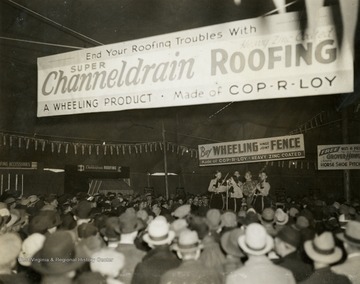
- IDNO:
- 048538
- Title:
- Large Crowd Gathered to Listen to Performers Underneath Copious Amount of Wheeling Steel Advertisements at National Cornhusking Championship, Marshall, MO
- Date:
- 1937
- Description:
- These performers were likely musicians on the "It's Wheeling Steel" radio broadcast. This radio broadcast was created by John L. Grimes, advertising executive at Wheeling Steel Corporation. The broadcast was ran exclusively by employees and family members of the Wheeling Steel Corporation. This excursion to Missouri was used to spread the name of the growing broadcast as well as to promote their products, including COP-R-LOY.

- IDNO:
- 048539
- Title:
- 'It's Wheeling Steel' Radio Broadcast Musicians Playing Outside of Train, to or From National Cornusking Championship, Marshall, MO
- Date:
- 1937
- Description:
- The group of musicians is likely the Rhythm Rangers. These musicians, like all employees of the "It's Wheeling Steel" radio broadcast, were either employees or family members of employees of the Wheeling Steel Corporation. This radio broadcast was company advertising executive John L. Grimes idea to promote both the company's product and its employees. It began broadcasting in 1936 and ended in 1944.
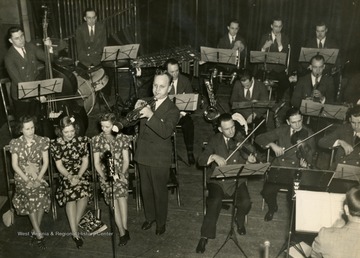
- IDNO:
- 048544
- Title:
- The Musical Steelmakers Accompany Tom Care During a Trumpet Solo
- Date:
- Undated
- Description:
- "The Steelmakers accompany Tom Care, employee from the Steubenville Works, as he headlines with a trumpet solo. Tom played "At The End Of a Perfect Day", which appealed to a great number of Wheeling Steel's nation-wide family."

- IDNO:
- 048545
- Title:
- The Musical Steelmakers Practicing Before Performance on 'It's Wheeling Steel' Radio Program
- Date:
- Undated
- Description:
- Caption on back of photograph reads: "Here's the same quintet on Sunday, running over a number before air time. Lew Davies is the conductor of the program's 23 piece orchestra of mill, plant, and office workers."
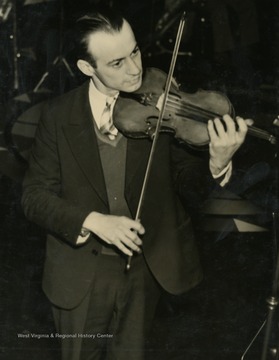
- IDNO:
- 048547
- Title:
- John Wisvari, Violin Player for Wheeling Musical Steelmakers
- Date:
- Undated
- Description:
- The Wheeling Musical Steelmakers were a group that would regularly perform on the "It's Wheeling Steel" radio broadcast, created in 1936 by John L. Grimes who wanted to promote both Wheeling Steel Corporations products and their employees. John Wisvari's day job was a pipe-threader at the Benwood Works.
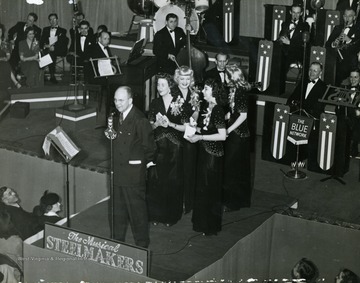
- IDNO:
- 048548
- Title:
- John L. Grimes Introducing the Steel Sisters, Performing With The Musical Steelmakers Band at Bond Drive, Fairmont, W. Va.
- Date:
- ca. 1943
- Description:
- John L. Grimes was advertising executive of Wheeling Steel Corporation and was responsible for the creation of the "It's Wheeling Steel" radio broadcast in 1936. In 1941 the show was picked up by the National Broadcasting Company's Blue Network, as it grew in popularity. The Steel Sisters and The Musical Steelmakers were regulars on the broadcast. The Steel Sisters became so popular that they eventually left the show to tour with Horace Heidt and his orchestra. In 1943 the show took to the road throughout several cities in West Virginia to put on "Buy a Bomber" themed shows, where the host cities were challenged to buy enough enough Defense Bonds to purchase a medium or large sized bomber. Cities who accomplished the challenge would get their name placed on the plane as it flew to battle.
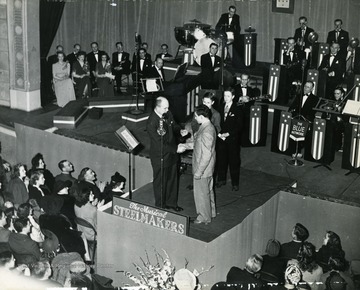
- IDNO:
- 048549
- Title:
- John L. Grimes Introducing Three Young Boys on Stage With The Musical Steelmakers Band at Bond Drive, Fairmont, W. Va.
- Date:
- ca. 1943
- Description:
- John L. Grimes was advertising executive of Wheeling Steel Corporation and was responsible for the creation of the "It's Wheeling Steel" radio broadcast in 1936. In 1941 the show was picked up by the National Broadcasting Company's Blue Network, as it grew in popularity (as evident by the microphone stands). In 1943 the show took to the road throughout several cities in West Virginia to put on "Buy a Bomber" themed shows, where the host cities were challenged to buy enough enough Defense Bonds to purchase a medium or large sized bomber. Cities who accomplished the challenge would get their name placed on the plane as it flew to battle.
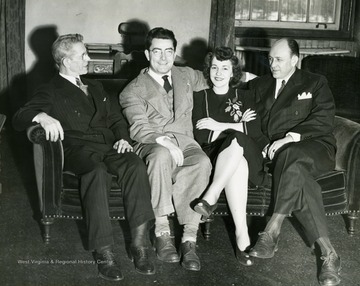
- IDNO:
- 048557
- Title:
- Regina Colbert and Tom Whitley Backstage at Bond Drive, Fairmont, W. Va.
- Date:
- ca. 1943
- Description:
- Center left: Tom Whitley, orchestra leader of the Musical Steelmakers of the Wheeling Steel Corporation. Center right: Regina Colbert, singer on "It's Wheeling Steel" radio program and secretary in advertising office. In 1943 the "It's Wheeling Steel" radio program took to the road throughout several cities in West Virginia to put on "Buy a Bomber" themed shows, where the host cities were challenged to buy enough enough Defense Bonds to purchase a medium or large sized bomber. Cities who accomplished the challenge would get their name placed on the plane as it flew to battle.
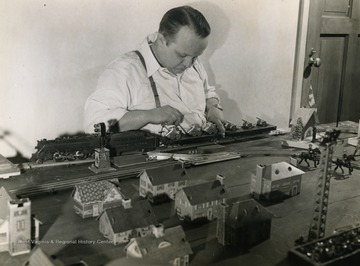
- IDNO:
- 048658
- Title:
- Bill Griffiths of Singing Millmen, Making Miniature Military Equipment
- Date:
- Undated
- Description:
- Caption on back of photograph reads: "Bill Griffiths makes military equipment during working hours, relaxes in his spare time by duplicating his day's work in miniature. he built the model guns and tanks shown here, and the train that carries them. On Sundays, he's one of the famed "Singing Millmen"." The Singing Millmen were regulars on the "It's Wheeling Steel" radio broadcast.